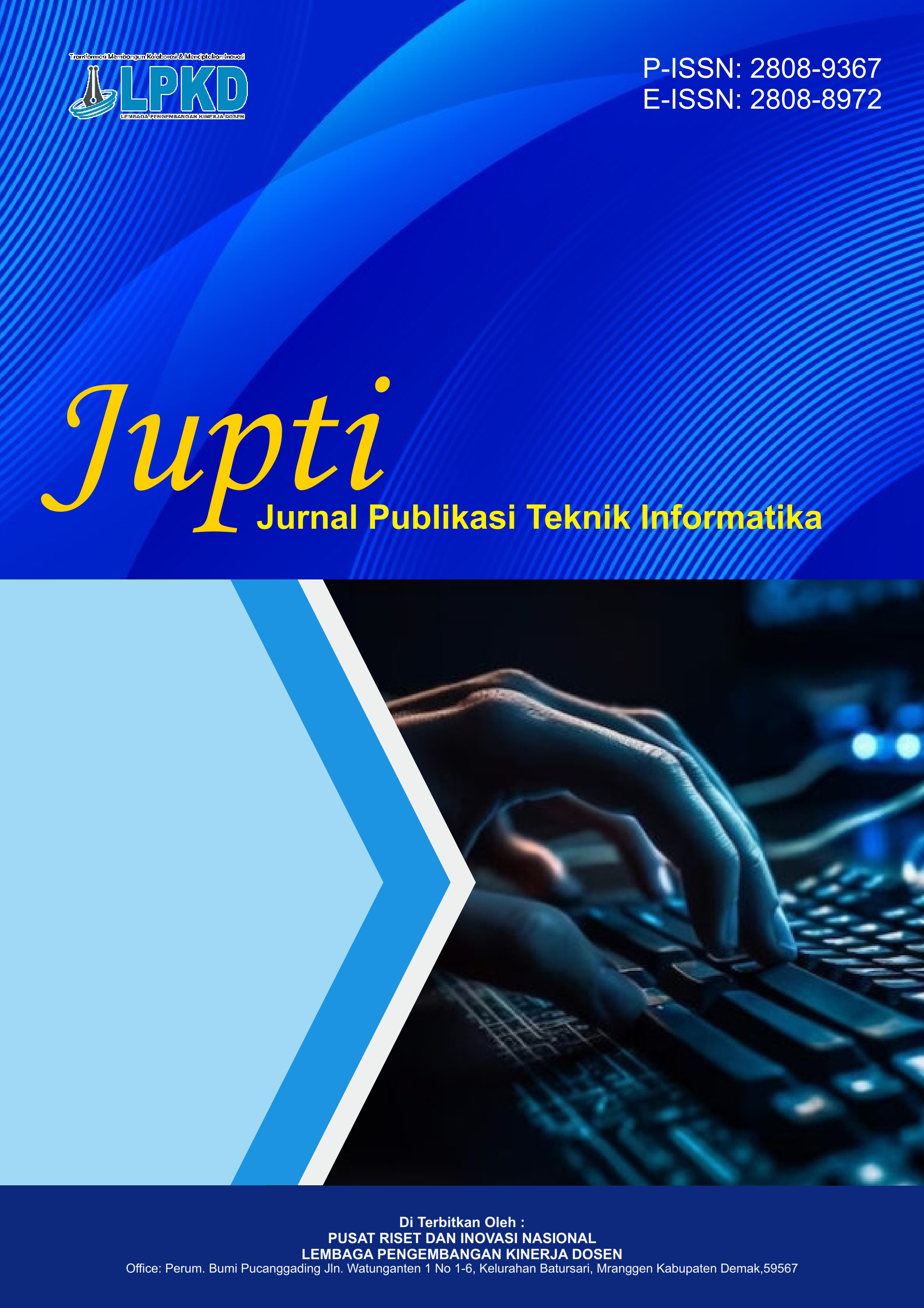Prediksi Status Gizi pada Balita Menggunakan Metode Long ShortTerm Memory
DOI:
https://doi.org/10.55606/jupti.v4i1.5506Keywords:
Long Short-Term Memory, Malnutrition, Nutritional Status Prediction, Time Series Data, Toddler Nutritional StatusAbstract
The high prevalence of malnutrition among toddlers in Pontianak City, adversely affecting growth, cognitive function, and future human capital. Despite monitoring efforts, traditional methods remain slow and less accurate. The objective is to develop an early prediction system for toddler nutritional status using a Long Short-Term Memory (LSTM) model based on anthropometric data (weight, height, age, gender) from the Pontianak City Health Office. The methodology comprises an applied experimental quantitative design with the following stages: data collection and preprocessing (cleaning, normalization, train-test split), LSTM model architecture development, model training, and performance evaluation using accuracy, precision, recall, and F1-score metrics. The dataset includes 1,182 samples of toddlers aged 0–60 months. Training results yielded 82% accuracy, 98% precision, 82% recall, and an F1-score of 89% on the training set. On the test set, the model achieved 79% accuracy, 99% precision, 80% recall, and an F1-score of 89%, with a weighted average F1-score of 0.83 and a macro average F1-score of 0.71, indicating solid overall performance but highlighting the need for improvement in underrepresented classes. The study’s implications involve enhancing the effectiveness of toddler nutritional monitoring, enabling faster interventions by healthcare workers, and contributing academically to the development of AI-based applications in public health.
References
Amalia, R. N., Azizah, M. F., Yuliantari, D., Lubis, F. J., Nabila, S. A., Sabila, V. P., ... & Flora, R. (2023). Ketahanan Pangan Terhadap Stunting Dan Wasting Pada Anak: A Systematic Review. Journal of Syntax Literate, 8(12). https://doi.org/10.36418/syntax-literate.v8i12.14224
Farhan, A. I., Hatta, A. H., Ramazan, D., Siahaan, F., Anwar, S., & Handono, F. W. (2025). Penerapan Algoritma Long Short Term Memory Untuk Memprediksi Pola Kenaikan Suhu Di Kota Jakarta Pusat. Jurnal INSAN Journal of Information System Management Innovation, 5(1), 43-52. https://doi.org/10.31294/j-insan.v5i1.9111
Heryati, A., Terttiaaivini, T., Marcelina, D., & Romli, H. (2025). Optimalisasi Prediksi Risiko Stunting dengan Model Hybrid Genetic-Machine Learning. Journal of Artificial Intelligence and Software Engineering, 5(2).
Ipmawati, J., & Unggara, I. (2024). Analisis Status Gizi Anak Menggunakan Metode Klastering pada Dataset Anthropometri. bit-Tech, 7(2), 494-504. https://doi.org/10.32877/bt.v7i2.1869
Muntiari, N. R., Hanif, K. H., Asma, A., & Herawati, L. (2025). Deteksi Stanting Pada Balita Dengan Menggunakan Perbandingan Algoritma Machine Learning. Jurnal Khatulistiwa Informatika, 13(1), 17-23.
Muntiari, N. R., Hanif, K. H., Asma, A., & Herawati, L. (2025). Deteksi Stanting Pada Balita Dengan Menggunakan Perbandingan Algoritma Machine Learning. Jurnal Khatulistiwa Informatika, 13(1), 17-23.
Natzir, S. M., & Jatiprasetya, H. (2025). Prediksi Harga Cryptocurrency Xlm Menggunakan Metode Deep Learning Lstm Dan Gru: Predicting Xlm Cryptocurrency Prices Using Lstm And Gru Deep Learning Models. HOAQ (High Education of Organization Archive Quality): Jurnal Teknologi Informasi, 16(1), 49-58. https://doi.org/10.52972/hoaq.vol16no1.p49-58
Oktafiani, R., Hermawan, A., & Avianto, D. (2023). Pengaruh komposisi split data terhadap performa klasifikasi penyakit kanker payudara menggunakan algoritma machine learning. Jurnal Sains dan Informatika, 19-28. https://doi.org/10.34128/jsi.v9i1.622
Pangestu, A., Purnamasari, A. I., & Ali, I. (2024). Analisis Peramalan Tingkat Pengangguran Terbuka di Jawa Barat: Pendekatan Time Series menggunakan Metode ARIMA. Jurnal Ilmu Komputer dan Teknologi, 5(1), 18-25. https://doi.org/10.35960/ikomti.v5i1.1298
Phitra, F. A., Lipoeto, N. I., & Yetti, H. (2023). Evaluasi pelaksanaan program pencegahan dan penurunan stunting di Desa Lokus Stunting Kabupaten Merangin tahun 2022. Jurnal Kebijakan Kesehatan Indonesia: JKKI, 12(3), 127-141. https://doi.org/10.22146/jkki.85424
Putri, A. I., Syarif, Y., Jayadi, P., Arrazak, F., & Salisah, F. N. (2023). Implementasi Algoritma Decision Tree dan Support Vector Machine (SVM) untuk Prediksi Risiko Stunting pada Keluarga: Implementation of Decision Tree and Support Vector Machine (SVM) Algorithm for Stunting Risk Prediction. MALCOM: Indonesian Journal of Machine Learning and Computer Science, 3(2), 349-357. https://doi.org/10.57152/malcom.v3i2.1228
Rahayu, N. (2025). Aggarwal, CC (2018). Artificial Neural Network and Deep Learning. Springer. Anderson, JA (1995). An Introduction to Neural Networks. The MIT Press. Bahdanau, D., Cho, K., & Bengio, Y.(2015). Neural Machine Translation. Deep Learning: Teori, Algoritma, dan Aplikasi, 9, 56.
Sona, M. A., & Dianto, A. Y. (2025). Deteksi Dini dan Edukasi Pencegahan Stunting melalui Posyandu dan Kelas Ibu Balita di RA Madania Joho Pace Nganjuk. Ngaliman: Jurnal Pengabdian Kepada Masyarakat, 4(2), 133-146.
Sunendar, N., Putro, H. P., & Hesananda, R. (2025). Prediksi Penjualan Aerosol Menggunakan Algoritma ARIMA, LSTM Dan GRU. INSOLOGI: Jurnal Sains dan Teknologi, 4(1), 113-126. https://doi.org/10.55123/insologi.v4i1.4868
Wahyu, F., & Hendrik, B. (2023). Perbandingan Algoritma Time Series Dan Fuzzy Inference System Dalam Analisis Data Deret Waktu. Jurnal Penelitian Teknologi Informasi Dan Sains, 1(3), 16-24. https://doi.org/10.54066/jptis.v1i3.711
Downloads
Published
How to Cite
Issue
Section
License
Copyright (c) 2025 Jurnal Publikasi Teknik Informatika

This work is licensed under a Creative Commons Attribution-ShareAlike 4.0 International License.








